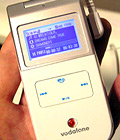New 3G Phones from Vodafone Japan
 Japan’s lost souls and the musically minded are targets for two new W-CDMA 3G handsets from Vodafone Japan, the 903T and 803T, both by Toshiba. Scheduled for an October release, the 903T finally puts Vodafone on the real-time mobile GPS navigation map (rivals DoCoMo and KDDI have had network GPS phones for some time). Vodafone’s “Live Navi” navigation portal goes the competition one better with the addition of GPS global roaming options in the UK, Hong Kong, Holland, Spain and Germany — with more countries to follow. Of course, international roaming and Vodafone live! communication charges will apply, which might make it cheaper just to buy a guidebook.
Japan’s lost souls and the musically minded are targets for two new W-CDMA 3G handsets from Vodafone Japan, the 903T and 803T, both by Toshiba. Scheduled for an October release, the 903T finally puts Vodafone on the real-time mobile GPS navigation map (rivals DoCoMo and KDDI have had network GPS phones for some time). Vodafone’s “Live Navi” navigation portal goes the competition one better with the addition of GPS global roaming options in the UK, Hong Kong, Holland, Spain and Germany — with more countries to follow. Of course, international roaming and Vodafone live! communication charges will apply, which might make it cheaper just to buy a guidebook.
Here in Japan, the navi service will map out routes according to specialized needs — like fewer stairs or covered access for when those typhoons hit. Vodafone’s main partner in mapping is well-known navigation data supplier Zenrin, which handles most of the live walk-through navigation and panorama shots via a split screen to show users just what they should be seeing on their route. Other partners specialize in train and subway routing, area-based restaurant maps or shopping information, as well as an international travel info site.

